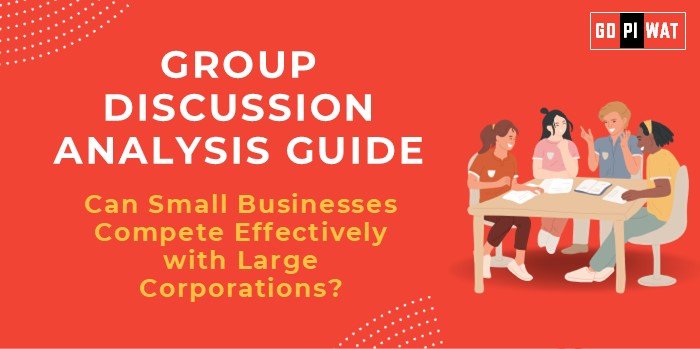📋 GD Analysis Guide: Can Small Businesses Compete Effectively with Large Corporations?
🌐 Introduction to the Topic
- Opening Context: Small businesses constitute the backbone of most economies, offering innovation, employment, and regional stability. However, they often face significant competition from resource-rich large corporations, raising questions about their sustainability and growth.
- Topic Background: With globalization and digital transformation leveling the playing field in some ways, small businesses now have access to tools like social media, e-commerce platforms, and fintech solutions. The discussion evaluates whether these advantages are sufficient to overcome scale disadvantages.
📊 Quick Facts and Key Statistics
- 🌍 Global SME Contribution: Small and medium enterprises (SMEs) account for 90% of businesses worldwide and contribute 50% of global GDP (World Bank, 2023).
- 🛒 Digital Transformation: 68% of SMEs use e-commerce platforms to increase reach, with global online sales reaching $6 trillion in 2023 (Statista).
- 👩💼 Employment: SMEs provide 70% of global employment but are more vulnerable to economic downturns.
- 💰 Funding Challenges: 40% of SMEs in developing nations face credit constraints, hindering their scalability (IMF).
🌟 Stakeholders and Their Roles
- 🏛️ Government Agencies: Provide support through tax benefits, funding schemes, and infrastructure.
- 🏦 Financial Institutions: Offer loans, crowdfunding, and microfinance to bridge funding gaps.
- 🏢 Large Corporations: Can serve as partners or competitors, influencing market dynamics.
- 💻 Technology Platforms: Enable small businesses to reach wider audiences.
- 👥 Consumers: Drive demand for localized and personalized services/products.
🏆 Achievements and Challenges
Achievements
- 💻 Digital Empowerment: Platforms like Shopify enable small businesses to sell globally.
- 🏘️ Local Strengths: Personalized customer service and niche markets.
- 🚀 Adaptability: Quick response to trends compared to slower-moving corporations.
- 📖 Case Study: A D2C startup in India leveraged Instagram ads to achieve $1M revenue in under a year.
Challenges
- ⚙️ Economies of Scale: Large corporations enjoy lower costs per unit and extensive distribution networks.
- 💸 Access to Capital: SMEs often lack funding and struggle to scale operations.
- 🎯 Brand Visibility: Competing with corporate advertising budgets is difficult.
Global Comparisons
- 🇨🇳 China: Government subsidies enable small manufacturers to thrive alongside corporate giants like Huawei.
- 🇪🇪 Estonia: E-residency programs empower SMEs to operate globally.
📚 Structured Arguments for Discussion
- 🟢 Supporting Stance: “With the rise of e-commerce, small businesses can target niche markets globally, reducing dependency on local foot traffic.”
- 🔴 Opposing Stance: “Large corporations dominate markets through economies of scale and massive advertising budgets, stifling competition.”
- ⚖️ Balanced Perspective: “Small businesses can compete in niche markets but need better access to funding and technology to scale sustainably.”
💡 Effective Discussion Approaches
- Opening Approaches:
- 📊 Statistical Impact: “With SMEs contributing 50% of global GDP, they’re pivotal to economic stability despite challenges.”
- 🎭 Contrast: “While large corporations dominate, small businesses leverage customer loyalty and innovation to compete.”
- 📖 Case Study Opening: Highlight a successful SME story, such as Airbnb initially competing with established hotel chains.
- Counter-Argument Handling:
- ✔️ “Corporations dominate in scale, but SMEs provide unique offerings tailored to local markets.”
- 🤖 “Access to technology like AI can help SMEs compete effectively by improving efficiency and reducing costs.”
📊 Strategic Analysis of Strengths and Weaknesses
- 🌟 Strengths: Customer loyalty, innovation, adaptability.
- ⚠️ Weaknesses: Limited funding, lack of infrastructure.
- 💼 Opportunities: E-commerce, regional market focus, partnerships with corporations.
- ⚡ Threats: Market saturation, rising competition from startups and corporations.
🎓 Connecting with B-School Applications
- 📈 Real-World Applications: Topics for projects on SME funding mechanisms, operational strategies, or digital marketing case studies.
- 📋 Sample Interview Questions:
- “What role does technology play in helping SMEs compete with large corporations?”
- “How can public policy support small business growth?”
- 💡 Insights for B-School Students: Explore entrepreneurship in niche markets, collaborative partnerships with larger firms, or fintech-based solutions for SMEs.


